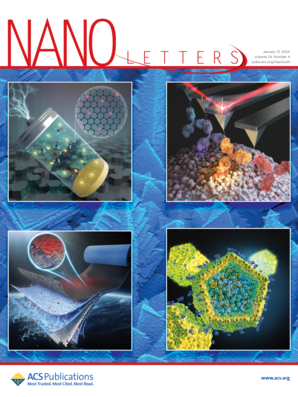强激子约束下近红外InAs胶体量子点的高纯度单光子发射
IF 9.6
1区 材料科学
Q1 CHEMISTRY, MULTIDISCIPLINARY
引用次数: 0
摘要
胶体量子点(QDs)由于其易于与纳米光子元件集成且生产成本低,是量子信息处理中很有前途的固态单光子发射器。然而,基于近红外qds的电信单光子发射器的研究仍然有限。在这里,我们提出了明亮的近红外InAs/InP/ZnSe/ZnS量子点,通过在核心内的强激子约束实现了高纯度的单光子发射。单量子点测量表明,这种约束可以实现超快双激子俄歇复合,抑制多光子的产生,并导致室温下g(2)(0)值低至0.032。与广泛研究的具有准II型带对齐的基于cd的量子点不同,这种量子点在单光子纯度和闪烁抑制之间存在权衡,我们的量子点利用厚绝缘ZnSe外壳,通过屏蔽光生激子免受表面相互作用而最小化光致发光闪烁,而不影响单光子纯度。这项研究为实现近红外量子点稳定、高纯度的单光子发射提供了一种可行的策略,突出了它们作为无重金属量子光源在电信应用中的潜力。本文章由计算机程序翻译,如有差异,请以英文原文为准。

High-Purity Single-Photon Emission in Near-Infrared InAs Colloidal Quantum Dots with Strong Exciton Confinement
Colloidal quantum dots (QDs) are promising solid-state single-photon emitters for quantum information processing due to their facile integration with nanophotonic components and cost-effective production. However, research on near-infrared QDs-based single-photon emitters for telecommunications remains limited. Here, we present bright near-infrared InAs/InP/ZnSe/ZnS QDs that achieve high-purity single-photon emission through strong exciton confinement within the core. Single-QD measurements reveal that this confinement enables ultrafast biexciton Auger recombination, suppressing multiphoton generation and resulting in g(2)(0) values as low as 0.032 at room temperature. Unlike extensively studied Cd-based QDs with quasi-type II band alignment, which suffer from a trade-off between single-photon purity and blinking suppression, our QDs leverage a thick insulating ZnSe shell to minimize photoluminescence blinking by shielding photogenerated excitons from surface interactions without compromising single-photon purity. This study offers a viable strategy for achieving stable, high-purity single-photon emission in near-infrared QDs, highlighting their potential as heavy-metal-free quantum light sources for telecommunications applications.
求助全文
通过发布文献求助,成功后即可免费获取论文全文。
去求助
来源期刊

Nano Letters
工程技术-材料科学:综合
CiteScore
16.80
自引率
2.80%
发文量
1182
审稿时长
1.4 months
期刊介绍:
Nano Letters serves as a dynamic platform for promptly disseminating original results in fundamental, applied, and emerging research across all facets of nanoscience and nanotechnology. A pivotal criterion for inclusion within Nano Letters is the convergence of at least two different areas or disciplines, ensuring a rich interdisciplinary scope. The journal is dedicated to fostering exploration in diverse areas, including:
- Experimental and theoretical findings on physical, chemical, and biological phenomena at the nanoscale
- Synthesis, characterization, and processing of organic, inorganic, polymer, and hybrid nanomaterials through physical, chemical, and biological methodologies
- Modeling and simulation of synthetic, assembly, and interaction processes
- Realization of integrated nanostructures and nano-engineered devices exhibiting advanced performance
- Applications of nanoscale materials in living and environmental systems
Nano Letters is committed to advancing and showcasing groundbreaking research that intersects various domains, fostering innovation and collaboration in the ever-evolving field of nanoscience and nanotechnology.
 求助内容:
求助内容: 应助结果提醒方式:
应助结果提醒方式:


